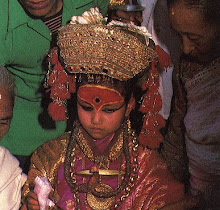Dashain, the biggest, the longest and the most auspicious festival in Nepal is celebrated in the month Kartik of Bikram Sambat (late September and early October). The festival is celebrated by Nepalese of all caste and creed throughout the country. The fifteen days of celebration occurs during the bright lunar fortnight ending on the day of the full moon. Through out the kingdom of Nepal the goddess Durga in all her manifestations are worshiped with innumerable pujas, abundant offerings and thousands of animal sacrifices for the ritual holy bathing, thus drenching the goddess for days in blood.
Dashain commemorates a great victory of the gods over the wicked demons. One of the victory stories told is the Ramayan, where the lord Ram after a big struggle killed Ravana, the cruel king of demons. According to the story, he got victory only after evoking goddess Durga. The main celebration glorifies the triumph of good over evil and is symbolized by goddess Durga slaying the terrible demon Mahisasur, who had been terrorising the earth in the guise of a brutal water buffalo. The first nine days signify the nine days of ferrous battle between goddess Durga and the demon Mahisasur. The tenth day is the day when Mahisasur was slain and the last five days symbolise the celebration of the victory with the blessing of the goddess. Dashain is celebrated with great rejoice, and goddess Durga is worshiped throughout the kingdom as the divine mother goddess.
People clean their home, beautifully decorate and paint to invite the mother goddess at their home and get blessed the house with good fortune. The festival is also known for reunion of distant and nearby relatives. Thousands of sheep, goats, ducks, chicken and water buffalo are prepared for sacrificing.
The first nine days of Dashain are called Nawa Ratri when tantric rites are conducted. In Nepal the life force is embodied in the divine energy and power of the female, depicted as goddess Durga in her many forms. All goddess who emanated from goddess Durga are known as devis, each with different aspects and powers. In most mother goddess temples a sacred Kalash, carved water jug or multiple handed goddess holding murderous weapons simply represents the deity. During these nine days people pay their homage to the goddess. Mother goddess is the source of life and everything. There is a belief that properly worshipping of the goddess drives to good fortunes while improper treating may cause misfortunes in the life.
The first day of Dashain is Ghatasthapana, which literally means pot establishing. On this day the kalash, (holy water vessel) symbolising goddess Durga often with her image embossed on the side is placed in the prayer room. The kalash is filled with holy water and covered with cowdung on to which seeds are sown. A small rectangular sand block is made and the kalash is put in the centre. The surrounding bed of sand is also seeded with grains. The ghatasthapana ritual is performed at a certain auspicious moment determined by the astrologers. A priest or a household man worships the kalash everyday once in the morning and then in the evening. The kalash and the sand are sprinkled with holy water everyday and it is shielded from direct sunlight. By the tenth day, the seed will have grown to five or six inches long yellow grass. The sacred yellow grass is called 'Jamara'. It is bestowed by the elders atop the heads of those younger to them during the last five days when tika is put on. The jamara is taken as a token of Goddess Durga as well as the elders blessing.
As days passes by regular rituals are observed till the seventh day. The seventh day is called 'Fulpati'. In fulpati, the royal kalash filled with holy water, banana stalks, jamara and sugar cane tied with red cloth is carried by Brahmans on a decorated palanquin. With this the Dashain feasting starts. Day next to Fulpati is Maha Asthami. On this day many orthodox Hindus go on holy fasting. Sacrifices are held in most of the house through out the day. The night of the eighth day is called 'Kal Ratri', the dark night. Hundreds of goats, sheep and buffaloes are sacrificed at the mother goddess temples. The sacrifice continues till dawn. The ninth day of the festival is Nawami. Temples of mother goddess are filled with people from dawn till dusk. Animals mostly black buffaloes are sacrificed to goddess Durga and might and to seek her blessing. On this very day the god Vishwa Karma, the God of creativity is also worshiped. All factories, vehicles, any machinery instruments and anything from which we make a living are worshiped and give sacrifices to get the blessing from goddess Durga for protection for vehicles and their occupants against accidents during the year.
The tenth day is Dashami. On this day younger people make visit to their elders to take tika and jamara from our elders and receive their blessing. The importance of Dasain also lies in the fact that on this day family members from far off and distant relatives come for a visit as well as to receive tika from the head of the family. This function continues for four days. After four days of rushing around and meeting relatives Dashain ends on the full moon day, the fifteenth day, also called 'Kojagrata'. On this day, the Hindu goddess of wealth Laxmi is worshipped.
After Dashain everyone settles back to normal. After receiving the blessing of goddess Durga, people are ready to work and acquire virtue, power and wealth. Dashain thus is not only the longest festival but also the most anticipated one among all the festivals of Nepal.
Reference:
- Karki,A. “Dashain Festival in Nepal”, www.visitnepal.com/nepal_information/dashain.php
- Karki, A. “Dashain”, www.info-nepal.com/society/festivals/dashain.html

